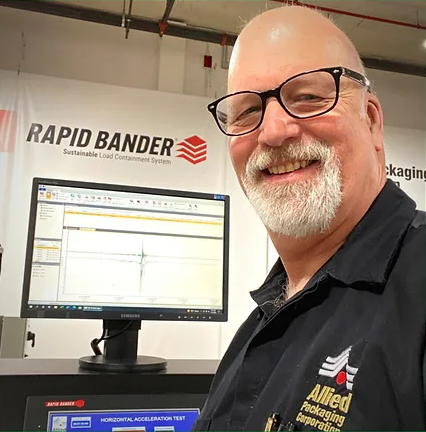Ask Steve
March 16, 2023
Question from Eli: How much film should we be using to wrap our pallets?
Hi Eli, thanks for submitting your question! There are several factors that come into play when determining the right amount of film to apply. First and foremost is to identify what is most important to you. Limiting stretch film cost per pallet, preventing load failures during transportation (or in the warehouse), or reducing source material are the three main categories. For some, it may be increasing capacity or throughput, without adding facility, equipment, or personnel by reducing the number of wraps applied, although I know that does not apply in your case.
If the value of your product is very high, then the cost of the film you apply is insignificant – compared to damaged product, or your customer rejecting an entire load. Load containment will be the overriding priority. However, if your product value is low, and the nature of the load is such that it is easily contained, you will most likely want to focus on applying the least amount of stretch film and worry less about containment. Each application is unique, so unfortunately, there is no one-size-fits-all when it comes to the amount of film to use.
Over the years, load containment standards (which includes film weight, force-to-load, and more recently, total applied stretch) have been established through trial and error. If your customer complains about damage, or they reject loads, the easiest solution is to just apply more film, until the complaints stop. While it is not very scientific, it has been the standard practice for quite some time.
The overwhelming majority of companies apply far too much film to their loads, increasing their cost per pallet, most often without the benefit of improved load containment. That happens because there is a limit to the load containment you can achieve by simply applying more film. Here’s why that is. Stretch film has a cling feature that allows it to grip onto the previous layer of film or wrap. When you partially stretch the film, it has a memory, like a rubber band. Each layer applied multiplies the film’s memory, and at the same time, multiplies the force the film applies to directly the load as it retracts. That is the reason adding more wraps has always been the go-to solution.
However, there are a couple of reasons that logic doesn’t always work. The force being applied to the load increases as you apply more film, to the point it crushes your product. But if the force applied to the load significantly increases with added film, it is an indication that film has not reached the level (or percentage) of stretch needed to increase its stiffness (or the resistance to stretch further). This is important because film that is only partially stretched will continue to stretch under the normal stresses of transit. This is called secondary stretch and it leads to failure because the load is not unitized; in other words, the individual components in the load move independently of one another. Less film at higher stretch improves load containment without having to apply so much film and the resulting force to the load that it crushes product.
Conventional film typically cannot be stretched to the percentage necessary for optimal performance without breaking the web as the pallet is being wrapped. Pre-stretch and applied tension must be reduced to eliminate web breaks, which means the ONLY way to increase load containment is to apply more film.
Understanding the science of load containment has allowed us to develop our film, and the process, to reach the peak performance by stretching the film a minimum of 50% more than conventional film. By incorporating reinforcement bands into the full web, we also virtually eliminate web breaks. The benefit to you is that we can apply significantly less film to the load with much higher levels of load containment – and not crush your product. I know that your product carries a high value, your loads are difficult to contain, and you suffer from web breaks during the wrap cycle. I believe we have a trial set up in one of your facilities shortly. This will give you a chance to see first-hand what I have described. As they say; “The proof is in the pudding”! In speaking with our Field Service Engineer, I believe your film usage will be cut in about half while your load containment will improve by around 280%.
While our Rapid Bander may not be the solution for every application, it has been a salvation for many with applications, just like yours.
As always, thanks for asking!








